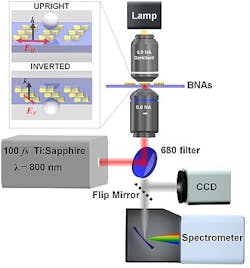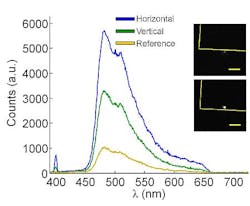Femtosecond laser-driven optical nanotweezers could help cellular-level studies
Using ultra-low input power densities, researchers at the University of Illinois at Urbana-Champaign (Champaign, IL) have demonstrated for the first time how low-power optical nanotweezers can be used to trap, manipulate, and probe nanoparticles, including biological samples.
Already knowing that plasmonic nanoantennas enhance local fields by up to several orders of magnitude, explains Kimani Toussaint, Jr., assistant professor of mechanical science and engineering, the reserachers have previously shown that they can use them with a regular continuous-wave (CW) laser source to make optical tweezers. But now, they have shown for the first time that the near-field optical forces can be enhanced even further by exploiting the high-peak powers associated with using a femtosecond laser source. With the femtosecond laser, the researchers used an average power of 30 µW to trap, manipulate, and probe nanoparticles, which equates to 100x less power than a standard laser pointer, he explains.
In their paper, the researchers describe how a femtosecond-pulsed laser beam significantly augments the trapping strength of gold bowtie nanoantenna arrays (BNAs) and the first demonstration of use of a femtosecond laser for optical trapping with plasmonic nanotweezers.
The research team's system operates at average power levels approximately three orders of magnitude lower than the expected optical damage threshold for biological structures, which makes their technology useful for biological applications such as cell manipulationâsuch as lab-on-a-chip, adds Toussaint. Their system's increased local diagnostic capabilities permit probing of the nonlinear optical response of trapped specimens, enabling studies of in-vitro fluorescent-tagged cells or viruses using a single line for trapping and probing rather than two or more laser lines, he says.
Brian Roxworthy, a graduate student in Toussaint's Photonics Research of Bio/nano Environments (PROBE) lab group and first author of the paper, notes that the researchers have shown that a femtosecond source could augment the near-field optical forces produced by the BNAs and, most likely, other nanoantenna systems as well. Their demonstration of controlled particle fusing could be important for creating novel nanostructures as well as for enhancing the local magnetic field response, which will be important for the field of magnetic plasmonics, he adds.
The paper also demonstrated enhancement of trap stiffness of up to 2x that of comparable CW nanotweezers and 5x that of conventional optical tweezers that employ a femtosecond source; successful trapping and tweezing of spherical particles ranging from 80 nm to 1.2 µm in diameter, metal, dielectric, and both fluorescent and non-fluorescent particles; enhancement of two-photon fluorescent signal from trapped microparticles in comparison to the response without the presence of the BNAs; enhancement of the second-harmonic signal of ~3.5x for the combined nanoparticle-BNA system compared to the bare BNAs; and fusing of gold nanoparticles to the BNAs.
Their recent paper, "Femtosecond-pulsed plasmonic nanotweezers," has been published in the September 17 issue of Scientific Reports. For more information, please visit http://www.nature.com/srep/2012/120917/srep00660/full/srep00660.html.
-----
Follow us on Twitter, 'like' us on Facebook, and join our group on LinkedIn
Laser Focus World has gone mobile: Get all of the mobile-friendly options here.
Subscribe now to BioOptics World magazine; it's free!


